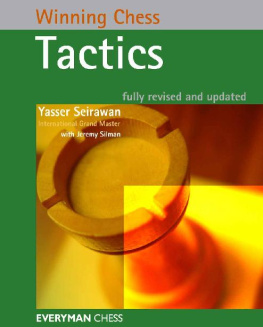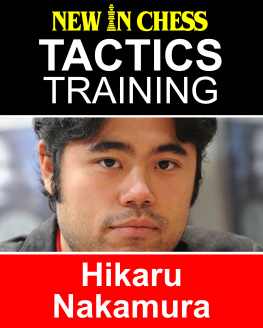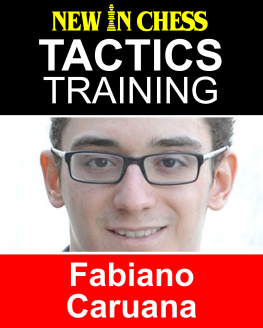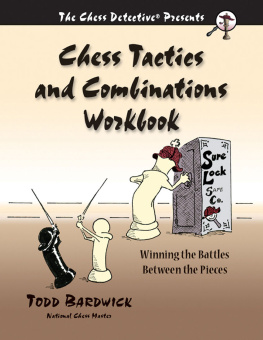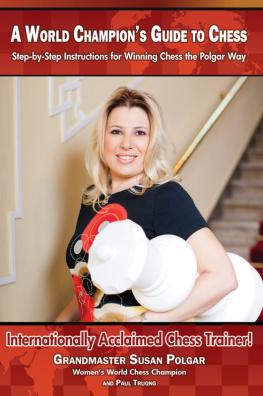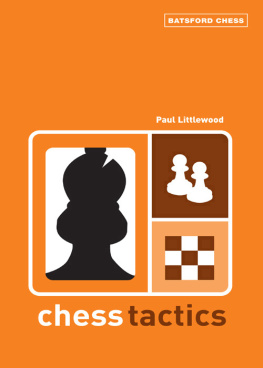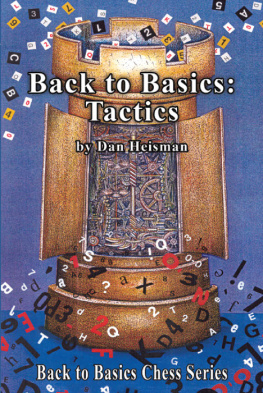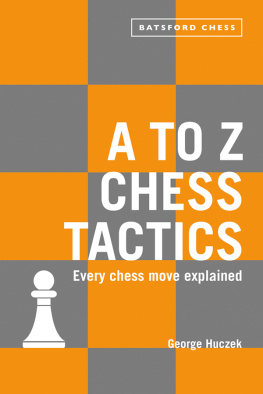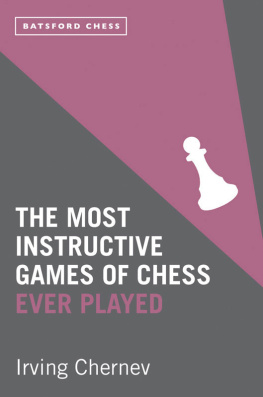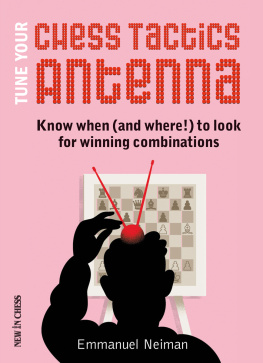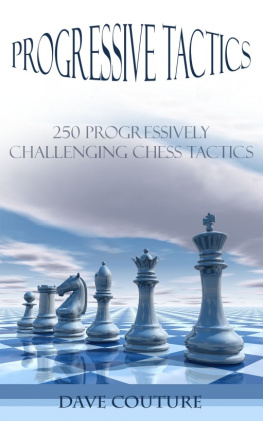Yasser Seirawan - Winning Chess Tactics
Here you can read online Yasser Seirawan - Winning Chess Tactics full text of the book (entire story) in english for free. Download pdf and epub, get meaning, cover and reviews about this ebook. year: 2011, publisher: Everyman Chess, genre: Home and family. Description of the work, (preface) as well as reviews are available. Best literature library LitArk.com created for fans of good reading and offers a wide selection of genres:
Romance novel
Science fiction
Adventure
Detective
Science
History
Home and family
Prose
Art
Politics
Computer
Non-fiction
Religion
Business
Children
Humor
Choose a favorite category and find really read worthwhile books. Enjoy immersion in the world of imagination, feel the emotions of the characters or learn something new for yourself, make an fascinating discovery.
- Book:Winning Chess Tactics
- Author:
- Publisher:Everyman Chess
- Genre:
- Year:2011
- Rating:3 / 5
- Favourites:Add to favourites
- Your mark:
- 60
- 1
- 2
- 3
- 4
- 5
Winning Chess Tactics: summary, description and annotation
We offer to read an annotation, description, summary or preface (depends on what the author of the book "Winning Chess Tactics" wrote himself). If you haven't found the necessary information about the book — write in the comments, we will try to find it.
Winning Chess Tactics — read online for free the complete book (whole text) full work
Below is the text of the book, divided by pages. System saving the place of the last page read, allows you to conveniently read the book "Winning Chess Tactics" online for free, without having to search again every time where you left off. Put a bookmark, and you can go to the page where you finished reading at any time.
Font size:
Interval:
Bookmark:
 British Library Cataloguing-in-Publication Data
British Library Cataloguing-in-Publication DataPublished by Gloucester Publishers plc, formerly Everyman Publishers plc, Northburgh House, 10 Northburgh Street, London EC1V 0AT
Copyright 2003 Yasser Seirawan
Revised edition first published 2005
All rights reserved. No part of the content of this book may be reproduced, stored in a retrieval system or transmitted in any form or by any means, electronic, electrostatic, magnetic tape, photocopying, recording or otherwise, without prior permission of the publisher.
British Library Cataloguing-in-Publication Data
A catalogue record for this book is available from the British Library.
ISBN 978 1 85744 714 9
Distributed in North America by The Globe Pequot Press, PO Box 480, 246 Goose Lane, Guildford, CT 06437-0480
All other sales enquiries should be directed to Everyman Chess, Northburgh House, 10 Northburgh Street, London EC1V 0AT
Tel: 020 7253 7887 Fax: 020 7490 3708
Email: info@everymanchess.com Website: www.everymanchess.com
In memory of Mikhail Tal.
Everyman is the registered trade mark of Random House Inc. and is used in this work under license from Random House Inc.
everyman chess series (formerly Cadogan Chess)
Chief Advisor: Garry Kasparov
Commissioning editor: Byron Jacobs
Printed and bound in the US by Versa Press.
Contents
)
Chapter Twenty-Five Solutions to Tests from Part 3
In my first book, Play Winning Chess , I discussed the history of chess and introduced the basic rules and strategies of the game. Teaching chess to beginners is an exercise in creativity. The teacher can go about the task in myriad ways. Some teachers might explain the rules and how the pieces move and then use the worlds great chess games especially their own as examples. Others might focus on how to play certain openings or how to checkmate. Though all of these methods may eventually lead to an understanding of the basics, some methods produce quicker results than others. In Play Winning Chess , I chose the most direct path.
I broke down the game of chess into its four elements force, time, space, and pawn structure and showed how these elements can be combined to produce a number of principles of play principles I deduced from studying thousands of master games. Understanding the four elements helps you understand the moves of the masters and inspires you to formulate plans of action in your own games.
After youve grasped the basics, its time to go to the next level of chess and explore the world of tactics. Only then can you fully appreciate the beautiful combinations that a mastery of tactics allows you to create. Whereas teaching beginner-level chess takes creativity, teaching tactics is a matter of conveying classical knowledge. The teacher can package this knowledge and spin it out in a variety of ways, but the knowledge is basically the same.
Winning Chess Tactics wont teach you anything about tactics and combinations that the chess world doesnt already know. However, Ive found that accessing this knowledge about these concepts can be anything but easy. Few of the books that teach combinative play explain tactics and combinations in an instructive manner. The rare exceptions tend to be for advanced players, making a study of this subject rather difficult for those with less experience. In this book, I divide tactics into themes, which I thoroughly explain and illustrate. Each chapter starts out with a discussion of the basic forms of the theme and progresses to increasingly more complex examples. This teaching technique allows for easy learning at the lower levels but also continues instruction right up to master class.
My goal is to enlighten beginner and tournament player alike!
Teaching for such a range of player strength has its drawbacks. For example, I dont stop to explain every chess term that I need to use, and as a result beginners will have it a little tougher here than in the first book.
I expect you to have some basic chess knowledge. In particular, you should know the following:
* How the pieces move
* The rules of the game
* How to read and write algebraic chess notation
* How to count the force (the value of the pieces)
* Basic chess terminology
* The four elements of chess and their associated principles, as expounded in Play Winning Chess
For lower-level players who might stumble over the chess terms in this book, Ive provided a glossary. My advice is to avoid skipping over terms that you are unfamiliar with. Look them up. Take the time to understand each term, and youll be able to take this book in stride.
A word about terminology of a different sort: Things havent changed much in the chess world since I wrote Play Winning Chess a year ago.
Chess players come in all colors, shapes, and sizes, but they are still overwhelmingly male. In this book, Ill continue to refer to chess players as he.
Hopefully, the situation will someday be different.
I strongly recommend a detailed study of the material in these pages for any aspiring chess player. After all, as nice as it is to admire the artistic combinations that the great chess players have given us, its much more satisfying to create them ourselves! And I hope this book will be the tool that allows you this satisfaction.
While you are studying tactics and combinations, you might find yourself spending long hours alone, huddled over your chessboard. As soon as youre ready, I advise you to get out and test your skills against those of other chess enthusiasts. Though reading this book will not guarantee that youll win, it might start you on your way to a championship.
The sport of chess is remarkably well organized; in fact, very few sports have such a large international network of players. Local clubs, states, and national federations organize club championships, state championships, and national championships. A scoring system of 1 point for a victory, point for a draw, and 0 points for a loss allows contestants to gradually attain Master, International Master and Grandmaster status.
The 170 national federations, including the US Chess Federation, all belong to the Fdration Internationale des checs (FIDE), which organizes the World Championships. The World Championships are contested for millions of dollars!
So join your local club, enter and win tournaments, and who knows, you might manage to bag yourself a championship.
Happy hunting!
Yasser Seirawan
Seattle, Washington
Part One
Tactics and Combinations
This part is the meat of the book. After defining tactics and combinations, I break them down into themes that I explain briefly before offering examples that illustrate the how to and why. Most of these examples are fairly basic, but occasionally I throw in something more difficult to show how the simplest tactic can be combined with another and yet another to produce something mind-boggling.
If an example is not clear to you, go over it many times. If you continue to draw a blank, go over the section again and again and again until your raw, paper-cut fingers cant turn another page, your bloodshot eyes see only the hazy outlines of chess boards, and you begin to wish you had never taken up the sport of chess! (Hmmm... Perhaps I should get out of the chess business and start a new career as a drill sergeant!)
Chapter One
Definitions
I know, definitions are boring. Youd probably just as soon skip them and jump right into a few juicy games. Be patient. Well get to the games and some of them are beauties soon enough. But before we delve into the world of tactics and combinations, we should begin by defining them. For some strange reason, these terms seem to cause confusion. Just what are tactics and combinations? Surprisingly, coming up with a satisfactory definition of these commonly used chess terms is more difficult than one might suppose.
Font size:
Interval:
Bookmark:
Similar books «Winning Chess Tactics»
Look at similar books to Winning Chess Tactics. We have selected literature similar in name and meaning in the hope of providing readers with more options to find new, interesting, not yet read works.
Discussion, reviews of the book Winning Chess Tactics and just readers' own opinions. Leave your comments, write what you think about the work, its meaning or the main characters. Specify what exactly you liked and what you didn't like, and why you think so.

